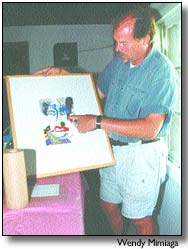|
Aug 18, 2001
By Ann Bond Sometimes less is definitely more. And sometimes you can go back in time, even if itís only for a week or two. Such are the lessons of the San Juan National Forest Artist-in-Residence Program. "Living out here requires you to focus and pay attention to what youíre doing," said mixed-media artist Wayne Rice of Cortez during his stay this week at the Aspen Guard Station north of Mancos. "Itís the simplicity out here ó chopping wood, building a fire to stay warm, reading by candlelight. Thereís none of the beeping, buzzing stuff that goes on at home." Since 1994, the Cortez Cultural Center and Durango Arts Center have helped the U.S. Forest Service choose up to six artists to live and work at the rustic cabin each summer and fall. Living a lifestyle of the past helps them focus, while the natural setting provides inspiration. "We rarely have an opportunity to get an artistís perspective on the value of public lands," said Toni Kelly, visitor information specialist for the Dolores Public Lands Center. "This program brings the agency together with the arts community, two entities that rarely interface. It has been very worthwhile for us and hopefully very rewarding for the public." Built by the Civilian Conservation Corps in the 1930s, the Aspen Guard Station was both home and office to the rangers of the old Montezuma National Forest who patrolled the forest on horseback. Later, the cabin served as quarters for seasonal fire and timber crews. But by the 1990s, it had stood empty for years and was in danger of demolition. Thatís when it found its second lease on life as headquarters for the Artist-in-Residence Program. "This has been like a reward for me," said Rice, who has also been selected for similar programs in New Mexico, Colorado, and Wyoming. "It has allowed me to look at the greater issues in my life and to contemplate what direction I want to go with my art." The lessons that artists learn through their experiences at the cabin are passed on through their donations of artwork and workshops. Rice is the third participant this summer to host a free public workshop in association with the program. Illustrator Holly Hagen of Durango sponsored an open house at the cabin in July, and author Paulla Ebron of California taught a writing class at the Cortez Cultural Center in early August. Rice offered basic instruction at the cabin this week in the art of monotype printmaking. The process starts with dabbing water or oil-based paint onto a blank plate. Rolling it through a press transfers the paint from the plate to paper. "If you just painted something, it would be an exact image, but when you run it through the press, it changes in unexpected ways that you can't predict," said Rice, a certified art teacher who has taught for the Santa Fe Children's Museum, National Park Service, and Mendocino Art Center. "I really like the parts of the process you can't control." After rolling the image through his miniature press, Rice showed how to use paintbrushes, toothbrushes, and eating utensils to scratch, blend and change the texture of a monotype print even further. "When you actually lift the print off is the magic moment, and you can leave it Ďas isí or you can manipulate it," he explained. "I like to take colored pencil and draw on the surface. It's done when you think it's done." The Artist-in-Residence Program is far from done this year. Artists from Telluride, Dolores and Durango will reside at the Aspen Guard Station through the change of the aspens next month. Their artistic results are sure to be as colorful as the season. And the lessons of life at the cabin will continue to inspire diverse ways of appreciating and interpreting natural resources and public lands. For Rice, the lesson was that teacher became pupil in the study of life. "Living a creative life might be as important as, or more important than, making beautiful objects," Rice said. The Aspen Guard Station Artist-in-Residence Program is operated through the Dolores Public Lands Center, which accepts applications annually between January and March. Application brochures are available at San Juan National Forest offices in Dolores and Durango, and at the Cortez Cultural Center and Durango Arts Center. Ann Bond is the public-affairs specialist for the San Juan National Forest. |
||
|
Copyright © 2001 the Cortez Journal.
All rights reserved. |
